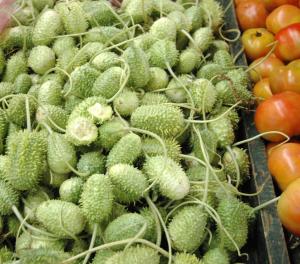Maxixe
“An onion can make people cry, but there has never been a vegetable invented to make them laugh.”
-Will Rogers (1879-1935)
During our first few weeks here, we visited a lot of local markets (no, really – a LOT). Almost everything was unfamiliar to me, but certain products stood out in my mind because of the way they looked – for their sheer uniqueness. I remember seeing this one in particular at almost every market:
and every time I wondered “What the heck is that thing?” I mean, really, to a Westerner, this looked like some sort of green mutant weapon, not a vegetable or a fruit. I was always too uneasy about its appearance to try it – something about the egg-shaped koosh ball with a tail just… didn’t look appetizing.
Luckily, one of my first tasks at DOM was to learn how to fabricate these little oddities, known as Maxixe (pronounced mah-SHE-shee). Maxixe is, of all things… a type of cucumber. Yeah, I was way off. They’re prickly, but not thorny – the spikes are more like rubber than rose bushes, and the small hairs on the long, curly stem are only slightly odd feeling. To eat these little guys, first trim off the tail and any nub that might be on the bottom end. With the side of a knife, gently scrape the spikes off (this took me at least 3-4 tries before I stopped mangling the skin – use very gentle pressure and keep the knife slightly angled upward) and rinse in cool water… and that’s it. Scraping the spikes off helps to preserve the color, flavor, and texture of the skin – but if you’re totally weirded out by the spikes, you can peel it completely. Maxixe can be eaten raw, but they are filled with seeds – so most people prefer them cooked. At DOM, the cleaned maxixe we prepare is diced and added to a ratatouille-style preparation used in Alex Atala’s other restaurant, Dalva e Dito (which is just down the street from DOM).
When I started my research on maxixe, the first dozen or so pages that came up were all related to a type of dance – apparently, Maxixe is the name of a Brazilian traditional dance that’s sometimes called the “Brazilian Tango”, an Afro-Brazilian dance developed by black Chopi slaves from… Maxixe, Mozambique.
Our little green edible koosh-balls most likely originated in Africa. At one point, they were thought to have originated from the West Indies – which is why sometimes you can find them labeled as “West Indian Gherkins.” Other places also call maxixe “Burr Cucumber”. I say ignore the labels – you’ll know it if you see it! Maxixe is popular in Northeastern Brazilian cuisine, where they have a stew called “Maxixada” ( recipe follows). Maxixe is also eaten raw in salads, pickled, boiled, or lightly sauteed. It tastes slightly sweet with just a little hint of bitter – I think they’d be great in the Greek Tzatziki sauce. As an added plus, they’re very low in calories and high in zinc.
I also found a website run by a group of students from the University of Massachusetts who specialize in growing “specialty” produce like this – they sell to local farmers markets in the Boston and Lancaster area. I couldn’t find information about finding maxixe anywhere else in the US, but this website sells the seeds for export if you’re feeling adventurous 🙂
Hot and Spicy Brazilian Maxixada
This dish is eaten over rice or a mixture of rice and beans. Traditionally, it’s cooked with dende oil (red palm oil), but you can substitute olive oil if you can’t find dende.
1/4 cup dende palm oil ( or olive oil )
2 cups onion, minced
1 pound young, tender maxixe
1 chayote, diced (peeled zucchini can serve as a substitute)
1 tbsp garlic, minced
2 cups tomato, chopped
8 ounces picked cooked crab meat
1 cup coconut milk
2 or 3 tbsp chopped cilantro, or to taste
Zest of half a lime
Salt and freshly chopped or ground hot pepper to taste (preferably malagueta)
Optional garnish: 4 boiled crabs cut in half
Heat oil in a large sauté pan or skillet and add onion, maxixe, and chayote or zucchini. Cover and cook 6 minutes over medium heat, then add garlic, tomato, picked crab and coconut milk. Stir and cook uncovered until the tomato is reduced and the sauce turns light orange (about 8 minutes). Add cilantro and lime zest, then season to taste with salt and hot pepper. Once the liquids are well combined and hot (about 5 minutes), serve over rice with hot boiled crabs as a garnish. Serves 4 to 6.
( recipe taken from here – the article preceding the recipe is really useful for planting and harvesting tips)



